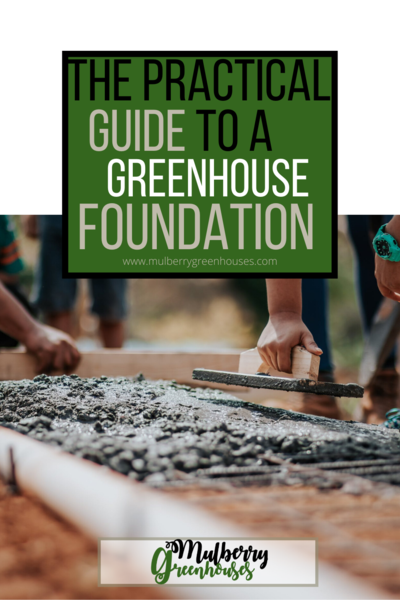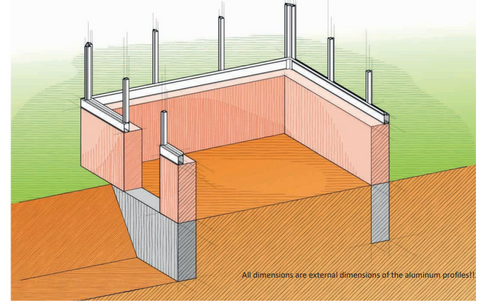
Foundation, flooring, or footer are often used interchangeably when speaking of a greenhouse. Regardless, it remains a system over which the greenhouse structure is set up. Home gardeners are often seen wondering how to go about ground preparation for installing their greenhouses; because there is surely more to it than being leveled.
The following are examples of different types of foundations that we will explore in this article.

What a Great Foundation Looks Like?
A storm is always brewing somewhere, and unless your foundation is secure and leveled out, even the well-built of all greenhouses wouldn’t stand a chance at stability. In addition, a leveled ground makes it fairly easy to assemble a greenhouse, and they last much longer this way. But most importantly, with a durable foundation, you won’t be troubled by drainage or water puddles that become a breeding ground for mold, algae, and other pests.
Doing the foundation right sets you free from the hassle of having to renew it every few years. Hence, Mulberry Greenhouses has taken the time to address the foundation, flooring, and footer:

Soil Foundation
The most basic foundation for a greenhouse is the compacted soil foundation that only needs a hand with leveling, so the frames don’t go on crooked. The great thing about a soil foundation is that you can grow plants into it. More advanced greenhouses include base frames and anchors to prevent the structure from being uplifted. It may not be the strongest of them all, but it surely is a cost-saving solution that offers better drainage and allows you to plant in the ground. In addition to compact dirt, road base or paving stone is also a great alternative.
More advanced greenhouses include base frames and anchors to prevent the structure from being uplifted. It may not be the strongest of them all, but it surely is a cost-saving solution that offers better drainage and allows you to plant in the ground. In addition to compact dirt, road base or paving stone is also a great alternative.
To turn up the appearance element, a brick-paved or stone foundation looks prettier than the soil but allows for water to run off just as great.
Concrete Slabs
Concrete slabs aren’t all that difficult to build; in fact, they offer a long-lasting base level that is virtually permanent. The trouble is that you might need to seek permission from the state to integrate slabs into your property as they become hazardous when deployed alongside overhead irrigation facilities.
base level that is virtually permanent. The trouble is that you might need to seek permission from the state to integrate slabs into your property as they become hazardous when deployed alongside overhead irrigation facilities.
However, a concrete slab is recommended in areas with warmer temperature because they can cause the slab to shift during freezing temperatures. That's why, the recommendation is to extend the foundation below frost line to create a stable ground for the greenhouse. Also, consider a good drainage system for the greenhouse, in addition to making sure that there is good texture for the slab because it can get really slippery when it's wet.
Perimeter Foundation

A perimeter foundation is a great type of foundation that provides structural support for the walls of the greenhouse. An example of a perimeter wall would be raising a greenhouse on a stem wall.
A Stem Wall helps elevate a greenhouse. It is a great way to add some vertical space for shelves or just to give the greenhouse grandeur and elegance. When building a greenhouse on a stem wall, you will need a drop door kit that will allow to drop the door down for easy access. A greenhouse base is not needed for these types of constructions. These bases are usually provided by the manufacturer as a part of the usual greenhouse kit. A basic perimeter foundation is necessary to make the wall more stable (this is not the only option).
allow to drop the door down for easy access. A greenhouse base is not needed for these types of constructions. These bases are usually provided by the manufacturer as a part of the usual greenhouse kit. A basic perimeter foundation is necessary to make the wall more stable (this is not the only option).

Wooden Foundation
This is a really inexpensive way to build a foundation. It consists of flattening the surface and creating a perimeter wood frame with a 4"x4" or 6"x6" (depending on the size of the greenhouse). We recommend naturally resistant wood like Cedar because it doesn't corrode the aluminum frame of the greenhouse. You will be forming a perimeter. Then you proceed by inserting a metal rebar into the wood frame in order to stablize and attach it to the ground. You will also use a lag screw to attach the timbers together. This is not recommended for huge greenhouses or commercial ones, and is mainly recommended for the smaller kits.
wood like Cedar because it doesn't corrode the aluminum frame of the greenhouse. You will be forming a perimeter. Then you proceed by inserting a metal rebar into the wood frame in order to stablize and attach it to the ground. You will also use a lag screw to attach the timbers together. This is not recommended for huge greenhouses or commercial ones, and is mainly recommended for the smaller kits.
NB: Timbers will likely decay before the life of the greenhouse is over, so we generally do not recommend this.
Wooden Decks
Don’t be mistaken by its natural resource tag, you’re still going to come across temperature problems because a wooden deck usually fails to offer insulation. However, it does make for an easy-to-clean foundation that drains any size of greenhouses well. Moreover, it’s permanent and offers a long-lasting level base.
across temperature problems because a wooden deck usually fails to offer insulation. However, it does make for an easy-to-clean foundation that drains any size of greenhouses well. Moreover, it’s permanent and offers a long-lasting level base.
The greenhouse should be anchored very securely using the appropriate hardware to attach it to the deck. The wind load in the area should be taken into consideration in order to determine proper attachment.
⚠ We always recommend checking with a local builders to find what the recommendation is for their area. The builder/contractor will take into consideration climate, ground composition and wind strength in the area to determine what option is good for you.
Ready to dig deeper into greenhouse foundation? Mulberry Greenhouses brings to you affordable greenhouse kits, greenhouses accessories, and smart grow closets from renowned brands (namely Exaco, Monticello, Riverstone, Riga, Lumen & Forge, Solexx, and Janssens greenhouse for sale). We take pride in begin a woman-owned business in the continental USA, serving a 100 percent price match guarantee on the items for sale.
Shop for greenhouse heaters, greenhouse grow lights, shade cloths, Aerobin 400 composters, greenhouse solar power system, shelves, Solexx greenhouse flooring, greenhouse watering system, tie-down kit, fans, door kits, and greenhouse cold frames from Mulberry Greenhouses.
